from our September 2014 issue
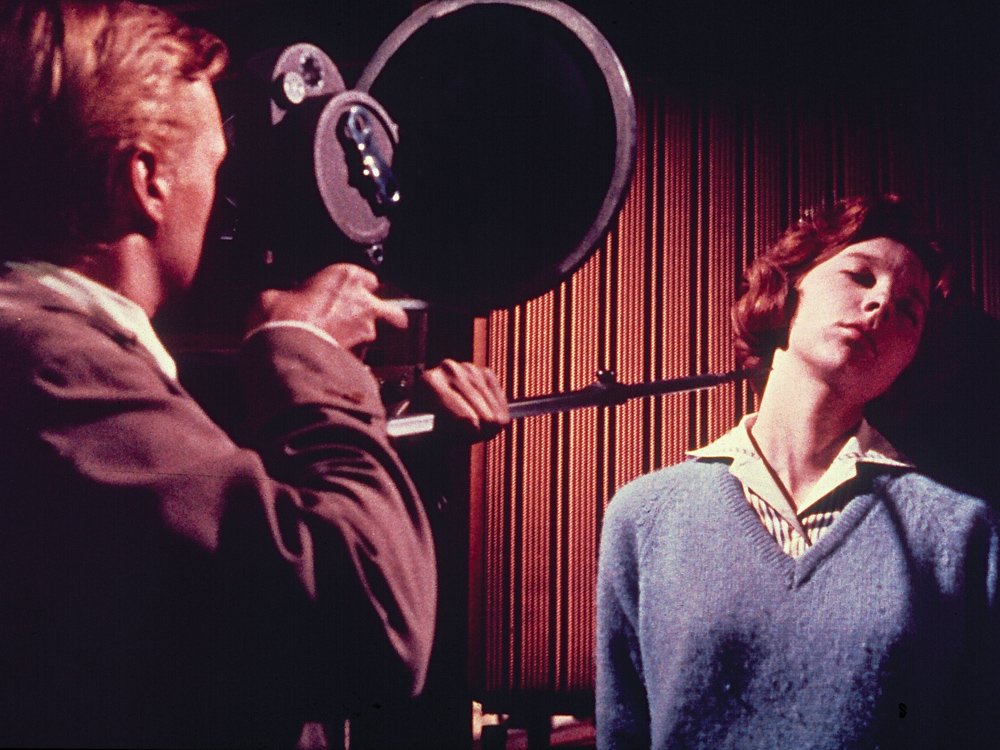
While Cahiers du Cinéma dismissed Michael Powell’s Peeping Tom as ‘totally platitudinous’, Raymond Durgnat was an early advocate of the film
No war broke out, nor was there an economic crash or general election, but 1963 has long been regarded as a watershed in modern British history. Above all it was the year of the Profumo scandal, which, as Richard Davenport-Hines argues in An English Affair, “sounded a death-knell to the confidence of traditional hierarchical authority”. Echoing this theme, it was a year that began with de Gaulle’s rejection of Britain’s application to join the Common Market and ended with the granting of independence to Kenya, one of the last major acts of decolonisation. It was also the year Beatlemania arrived and, partly because of Profumo, the peak of the satire boom.
A Sight & Sound discussion event, The Legacy of Raymond Durgnat, took place at BFI Southbank, London, on 5 September 2014.
The Essential Raymond Durgnat, edited by Henry K. Miller, is published by Palgrave Macmillan/BFI.
Well-covered though this territory is, however, few if any of the histories devote space to the overlapping argument that could be made for 1963 as an epoch in film culture, both in Britain and the US. In that realm it was the year the auteurists won. There too traditional hierarchical authority – ie Sight and Sound – was challenged, primarily by the Francophile critics of Movie. Three years earlier, in the autumn of 1960, S&S’s editor Penelope Houston had responded to the Cahiers du Cinéma-fuelled fervour of the same critics, who were then writing for the undergraduate magazine Oxford Opinion, with a long article which, among more reasonable points, accused the young cinephiles of using art as “something for kicks” and screen violence as a “handy stimulant”.
The controversy had broken in to the national press, and the Oxford Opinion writers had discovered that they had friends, notably in New York, where Andrew Sarris was waging a parallel war in the pages of Film Culture and the New York Film Bulletin. The most materially important ally, however, was probably Nicholas Luard, a university friend of Peter Cook who had used an inheritance to found the Establishment Club in 1961, and who began to publish Movie, as well as the fledgling Private Eye, in the spring of 1962.
The high point of Anglo-American Hitchcocko-Hawksianism came a year later. The spring of 1963 saw the opening of the Museum of Modern Art’s six-month-long Hitchcock retrospective, organised by Peter Bogdanovich, the appearance of Sarris’s special ‘American Directors’ issue of Film Culture, the basis for his 1968 book The American Cinema, and the publication in San Francisco’s Film Quarterly of Pauline Kael’s brilliant critique of auteurism, ‘Circles and Squares’. In London that spring, Movie, which numbered Sarris and Bogdanovich among its contributors, was actually being edited out of the Establishment Club, which was directly underneath the studio that produced the best-known image of Christine Keeler, published in the Sunday Mirror that June.
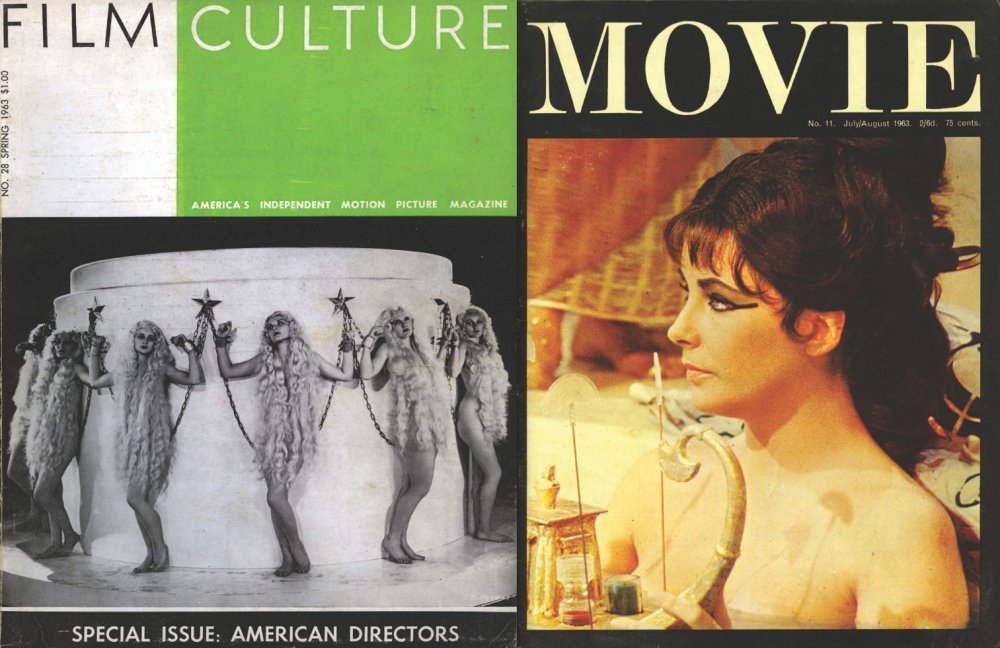
From right: Andrew Sarris’s 1963 special ‘American Directors’ issue of Film Culture; the Cleopatra cover of the July-August 1963 Movie
Time plays tricks with perspective, however. Things that were thought to have gone for good have come back to life; what was once vital is now exhausted. The emergence of Lord Home as prime minister, after Harold Macmillan’s resignation in the wake of Profumo, orchestrated by the ‘magic circle’ of Etonians who dominated their party, was instantly and for decades thought absurdly anachronistic – not quite so today. Conversely British ‘satire’ long ago lost its bite. The case of Movie is different. It was fated to be backward-looking because the Hollywood system in which its favourites had flourished was in decline. The cover of the July-August 1963 Movie, the last for two years – Luard having gone bankrupt – was a still from the era-ending Cleopatra, released that summer.
Apart from this, there is another story to tell about 1963, about another magazine, equally attuned to its times and resonating at least as much with the present. Motion first appeared in the summer of 1961, when its editor Ian Johnson was still a student at the LSE, before Movie but as part of the same general tumult. It had, at least in theory, a reciprocal distribution deal with the New York Film Bulletin. Whereas Movie was modishly laid out and printed using the latest offset litho process, Motion, Johnson recalls, had to use the “limited, old and sometimes battered typeface” of the cheapest hot-metal printer he could find. It had a print-run of 5,000, just over half that of Movie, a considerable figure given its lack of distribution muscle.
Like most such magazines, it didn’t pay and relied upon enthusiastic recent graduates for contributions; however, it also attracted the slightly older and better-established Raymond Durgnat, who as Johnson says “was always looking for outlets for his prolific writings”. Durgnat’s main outlet was Films and Filming, a monthly magazine of which there is no equivalent today. Part of a stable of titles – Books and Bookmen, Dance and Dancers, etc – founded by the eccentric Philip Dosse, it was slightly shambolic and became somewhat sleazy; yet it published some excellent work. Notably, as Justin Bengry has written, “among those who knew and could decode the magazine’s multiple voices”, it courted “Britain’s pre-decriminalisation homosexual community”.
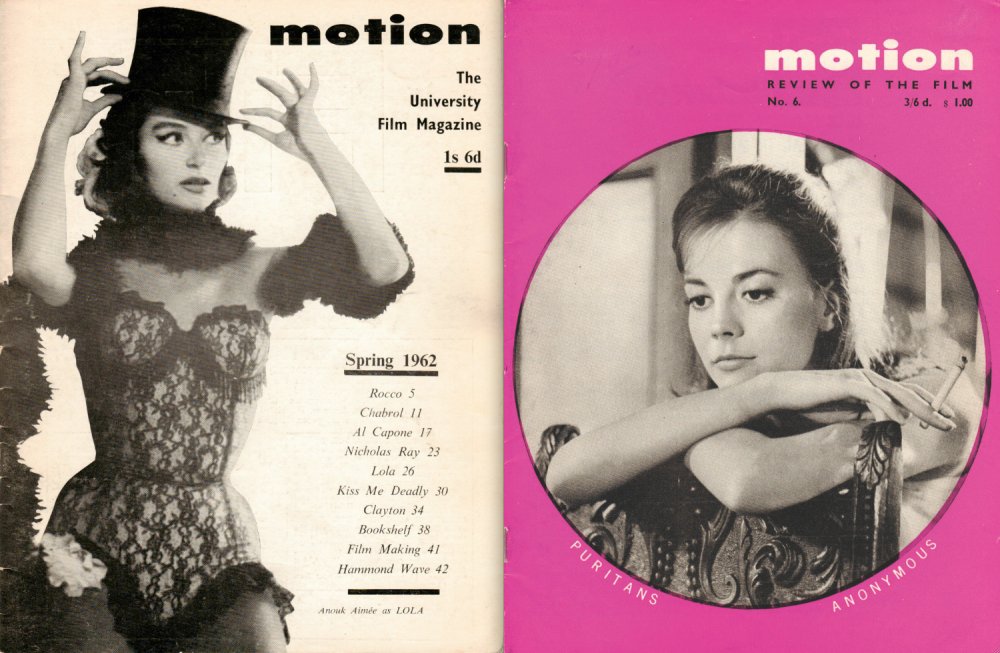
Two covers of Motion, a film magazine produced on shoestring budget and where Durgnat championed directors like Michael Powell
Durgnat’s first Motion contribution was a close reading of Aldrich’s Kiss Me Deadly (1955), pleasingly titled ‘The Apotheosis of Va-Va-Voom’, in the spring of 1962. The same issue promised from the same author a 40-page ‘Motion Monograph’ on the French New Wave for the summer. Covering 34 directors from Jean Gabriel Albicocco to Henri Zaphiratos, Nouvelle Vague: The First Decade appeared, more than double the planned length, in February 1963. Its highlights include a section on Jean Rouch and Edgar Morin’s Chronicle of a Summer (1961), written as a Chronicle of a Summer-style interview between Durgnat and the directors.
During its gestation Durgnat and Johnson, working out of Durgnat’s parents’ home in Chingford, also compiled the magazine’s crowning achievement, a ‘Companion to Violence and Sadism in the Cinema’, accurately described by Films and Filming as a “directory to the world’s most nasty pictures”. Starting with an entry on Mario Bava’s banned-in-Britain Black Sunday (1960) – whose star Barbara Steele stared out of the cover – it dealt with such topics as ‘Crustacea, Death by’, ‘Famous Movie Scars’ and ‘Leather’. There were longer articles on Georges Franju (by Peter Cowie, author of a Motion Monograph on Bergman), Science Fiction (by Philip Strick, who had written one on Antonioni), and the B western (by Chris Wicking, who later wrote a number of Hammer horror films, which he considered “the British equivalent of westerns”).
The ‘Companion’ was a celebration of everything that official film culture had excluded; while provocative, it was quite serious. Ray Connolly, who went on to write That’ll Be the Day (1973) – an evocation of pre-Beatles British youth culture that includes a clip from Horrors of the Black Museum (1959), a film discussed by Durgnat and Johnson under the heading ‘My Eyes, No, Not My Eyes’ – appended a bibliography to his entry on the ‘Psychology of Aggression’, invoking Freud, Melanie Klein and others. The preface, meanwhile, comprised a series of citations testifying to the prevalence of violence in Western culture, leading up to Houston’s trivialising comments on its use as a stimulant. One of Durgnat’s inspirations was Mario Praz’s The Romantic Agony, a catalogue of the erotic and morbid obsessions and archetypes that recurred throughout romantic and decadent literature. Thus he wrote, “There is no real horror without beauty, as Keats would have said if he could have beheld BLACK SUNDAY” (italics were a luxury Motion had to forgo).
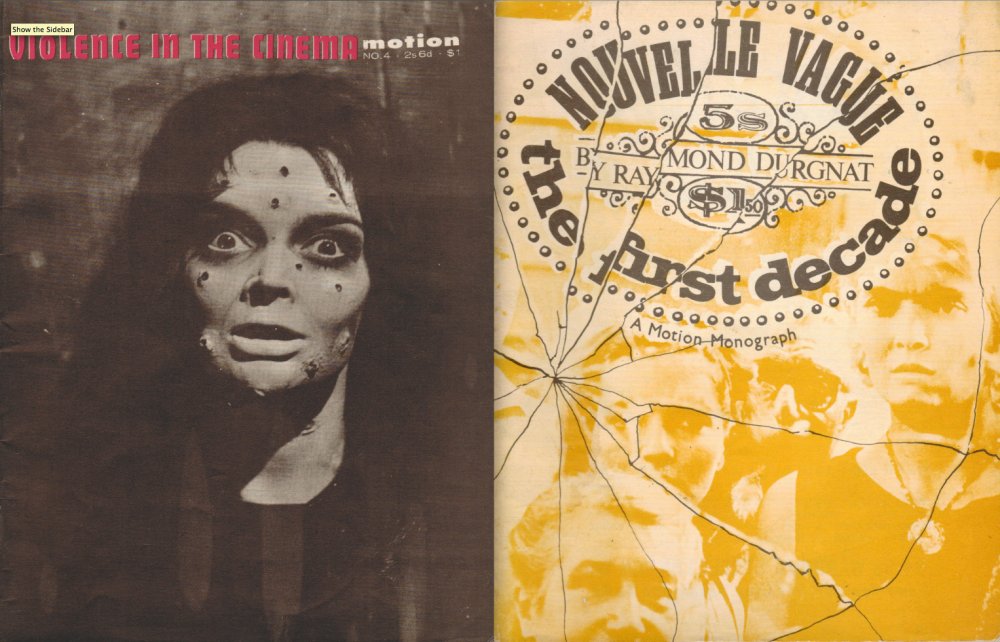
Two Durgnat-authored companions that Motion published: A Companion to Violence and Sadism in the Cinema (right) and the 40-page ‘Motion Monograph’ on the French New Wave (left)
As well as its challenge to S&S, by picking out recurrent features in different films, regardless of director or even genre, Motion also swam against the auteurist tide. Despite Nouvelle Vague, Durgnat, who had more in common with Kael than he could admit, had no time for Cahiers-inspired auteurism; Connolly recalls seeing Movie as “arch rivals”. And yet Motion played a major role in the auteur-isation of a filmmaker Movie thought merely “competent or ambitious” – Michael Powell – and in canonising a film Cahiers had dismissed as “totally platitudinous”: Peeping Tom (1960). Johnson’s entry ‘A Pin to See the Peepshow’ was the first article in English to treat the film with the seriousness it deserved. “As far as I know,” says Johnson, “Ray and I were the only people who appreciated the film’s values at that time.”
Durgnat had first discussed Peeping Tom in his Films and Filming series ‘Erotism in Cinema’, in which he argued, drawing on Morin’s concept of ‘projection-identification’, that “People don’t just see a film, they join in, identify, participate”. ‘Erotism’ here was not defined in an exclusively sexual way, but rather as something underlying other affective responses: “large erotic elements, under all sorts of camouflages and metamorphoses, lurk, or rather loom, in entertainment”, as he put it. “An essential part of films like Psycho and Peeping Tom is that the whole pattern of guilt, terror, suspicion, pity, hope-against-hope and so on, is brought into play.” Later in 1963 he described seeing Powell’s film with a regular audience, concentrating on the murder of Moira Shearer’s character. “In a suburban cinema full of respectable suburban housewives this scene creates extraordinary audience electricity. The victim is so nice, her death morally so atrocious, yet we can’t hate the killer because he’s so much of a victim too, yet we do hate him – the auditorium is full of gasps, chuckles, screams; people physically writhe as they empathise with the victim.” By disavowing these feelings, by divorcing the sensuous from the cerebral, the puritanical critical establishment had overlooked the film’s complexity.
Issued, in tandem with Nouvelle Vague, in the month before the Profumo story broke and the release of The Beatles’ first LP, the ‘Companion’ was, says Johnson, “our bestselling issue, especially in Soho”. By coincidence, Peeping Tom was being revived by the men-only, members-only Compton Cinema, on Old Compton Street, at exactly the same moment. From March onwards London reverberated with rumours about establishment vice – ‘le vice anglais’ very much included – spread not only by the Profumo affair, but by the Duke and Duchess of Argyll’s divorce proceedings. On 30 April Durgnat presided over “an evening on violence in the cinema” at the ICA, titled ‘The Art of Scaring You to Death’.

Raymond Durgnat
As an encore, Durgnat published in the next and final Motion, at the end of the summer, a direct attack on S&S, Free Cinema and related phenomena, titled ‘Standing Up for Jesus’ and advertised in S&S itself as “Sight & Sound exposed”. Arguably the British (and left-wing) equivalent of Truffaut’s ‘A Certain Tendency in French Cinema’, it exiled Durgnat from the BFI for almost two decades. Half a century on, however, with the BFI staging blockbuster gothic and sci-fi seasons, it appears that Motion’s moment has come. At the time it found its staunchest supporters across the Channel. In Paris Peeping Tom had won the admiration of Cahiers’s rivals at Positif, which had subsequently spun off a cult magazine, Midi-Minuit Fantastique, named after the cinema where Powell’s film had opened. Durgnat became its London correspondent, and would write his longest article on Powell for Positif in 1981. His first, in the autumn 1965 Movie, was a landmark in Powell’s critical rediscovery.
Durgnat came to look back on 1963 as a watershed for other reasons. He later described Fellini’s 8½, which reached London at the end of August, making striking use of Barbara Steele’s “art-school face”, as “art-house cinema at its peak, i.e. its evolution, between 1958 and 1963, (a) from social phenomenological realism to explorations of mental process and subjectivity, and (b) from predominantly dramatic narratives to a modernist poetic”.
Elsewhere the same dates reappear as those of Marker’s Letter from Siberia and Anger’s Scorpio Rising, which he saw as having revived the long dormant art of intellectual montage. Both developments led away from the ‘phenomenological realism’ of André Bazin, which was premised on a “famous (and bizarre) comparison of photography to the Holy Shroud of Turin” and forbade montage as artificial. In Durgnat’s contrary view photography was not essentially realistic, and film not essentially photographic. Affective and perceptual processes made it rather a matter of “images of the mind”, prompted by any means available.
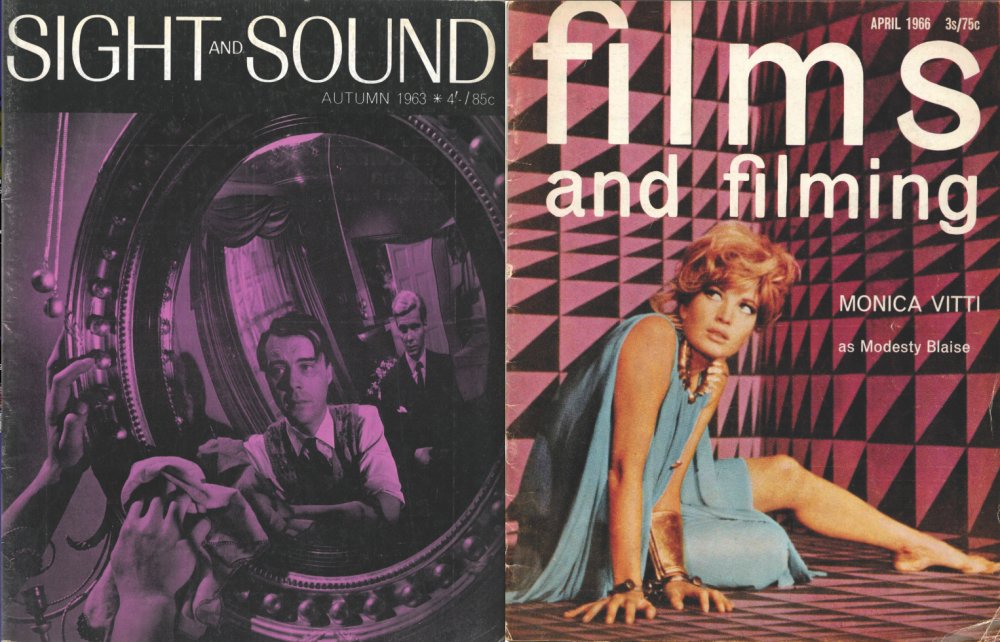
Durgnat wrote for the ‘slightly shambolic and somewhat sleazy’ Films and Filming (right), but fell out with Sight & Sound (left, with Joseph Losey’s The Servant on the cover) over its traditionalism
And for Durgnat the cinema of “mental images” and “sensuous contrasts” came to fruition in British cinema from 1963. November saw the West End opening of The Servant, later described by Durgnat as “a study of a whole culture’s loss of purpose and therefore self-assurance”, one month into the Douglas-Home premiership. The story of a dissolute aristocrat, “just back from Africa”, and his undoing by a butler likened to a vampire and peeping Tom, it held up a distorting mirror to the year’s events, even seeming to refer to the famous Keeler photograph. Losey had been championed both by Movie and by Motion: Robin Wood had written about The Criminal (aka Concrete Jungle, 1960) in the ‘Companion’, and Durgnat had called The Damned, produced by Hammer in 1961 and released without fanfare in May 1963, “one of the most important British films of the year, even, perhaps, of the 60s”. But with The Servant, Durgnat wrote in 1966, “Losey’s sensuousness reaches a climax”.
Nor was Losey alone in this breakthrough. Other exponents of what amounted to a British new wave, most of them trained in television and associated at one point or another with the beat boom, included Richard Lester, who made A Hard Day’s Night in the spring of 1964; Peter Watkins, whose BBC film Culloden, shown on BBC2 that December, applied the Rouch-Morin technique to 18th-century history; and perhaps above all Ken Russell, who made his first feature in the same year. Durgnat also included in this group John Boorman, apparently without knowing that Boorman had planted a copy of the Motion ‘Companion’ in the opening sequence of his 1964 BBC series The Newcomers, billed as a documentary but akin to and worthy of Fellini. Just as Bazin had theorised Italian neorealism in his time, so Durgnat would become the theorist of what he called the “Great British Phantasmagoria”, born of the era’s upheavals.
-
Sight & Sound: the September 2014 issue

The Greatest Documentaries of All Time poll, plus the documentary new wave, Laura Poitras, the Dardennes, Kelly Reichardt and Raymond Durgnat.
-
The Digital Edition and Archive quick link
Log in here to your digital edition and archive subscription, take a look at the packages on offer and buy a subscription.








